Last month we ventured out into the west desert in an attempt to locate and photograph buteos and Golden Eagles. With the exception of one adult Red-tailed Hawk and a (mostly uncooperative) Golden Eagle who let us get close it was largely a frustrating morning.
1/1600, f/5.6, ISO 640, 500 f/4, 1.4 tc, not baited, set up or called in
The red-tail was perched in a tree that was swaying in the wind and it was quite entertaining to watch it rockin’ and rollin’ as it attempted to remain stable on its unstable perch. It was largely hidden by the leaves most of the time but occasionally the wind would blow enough of them out of the way that I could see most of the bird. This is the most unobstructed perched shot I got.
I had to do some tricky maneuvering to get a good angle and light for a potential take-off by backing my pickup down and then back up a shallow ravine. I was surprised that the bird stuck until I reached a favorable spot but it did. So I took off my teleconverter (tc) and waited for launch…
1/2500, f/6.3, ISO 500, 500 f/4, not baited, set up or called in
which came 18 minutes after the first image in this post. This is the kind of shot that’s easy to miss after such a long wait. It takes great concentration and patience to remain focused on the bird for such a long time as you await for a take-off that happens very fast and often without warning. I swear that sometimes they watch me and deliberately wait until I’ve lost concentration for a nanosecond and then purposely choose that split second to launch.
This time I caught a pose that I like though I do wish the leaves weren’t in front of the face.
1/2500, f/6.3, ISO 500, 500 f/4, not baited, set up or called in
In a situation like this, nine times out of ten the bird will take off away from me and just give me butt shots but this hawk peeled off to my left and toward me.
1/2500, f/6.3, ISO 500, 500 f/4, not baited, set up or called in
When they do this I can’t help but wonder if the bird is curious about me and is deliberately checking me out.
1/2500, f/6.3, ISO 500, 500 f/4, not baited, set up or called in
I kept 20 sharp shots as the hawk got closer and closer and in each one it was watching us in the pickup as it approached – which is great for good eye contact.
1/2500, f/6.3, ISO 500, 500 f/4, not baited, set up or called in
Because of its elevated perch, once it gained speed it was largely gliding so…
1/2500, f/6.3, ISO 500, 500 f/4, not baited, set up or called in
I didn’t get any dynamic wing positions but I was still happy to get as many sharp flight shots as I did.
Did I have any luck with Golden Eagles? Hmppphhhh, you had to ask, didn’t you?…
Yes, I had some luck but it was all bad. We got close to one eagle but its perch was perhaps the worlds ugliest and when it took off – you guessed it…
Nothing but butt shots…
Ron


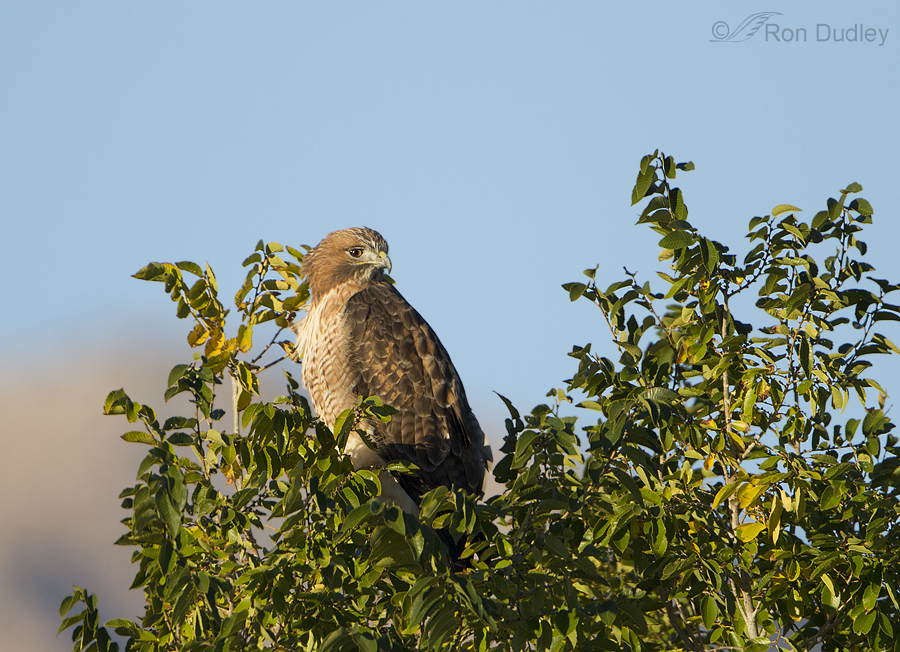
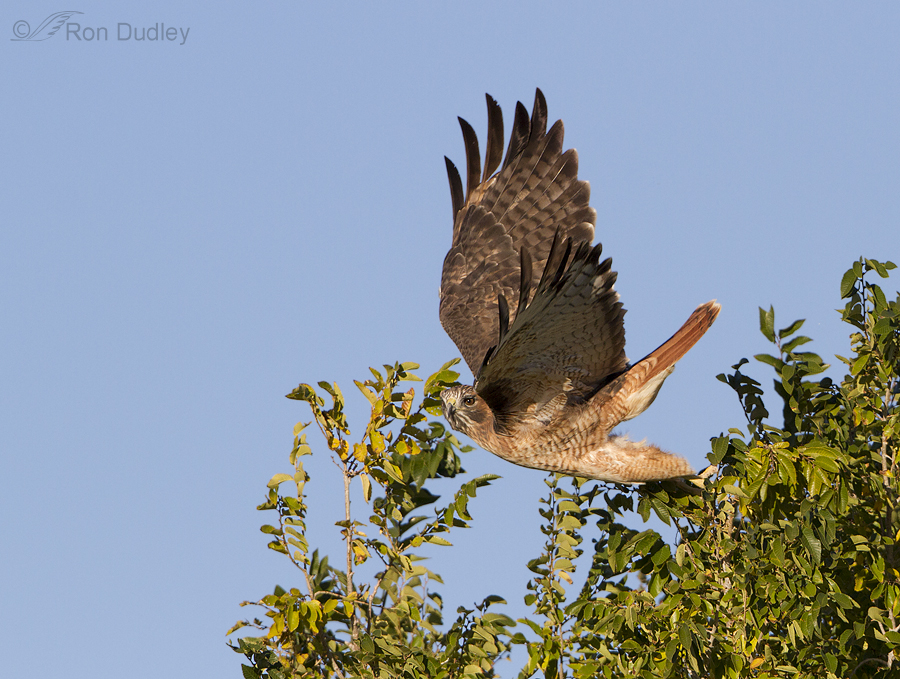
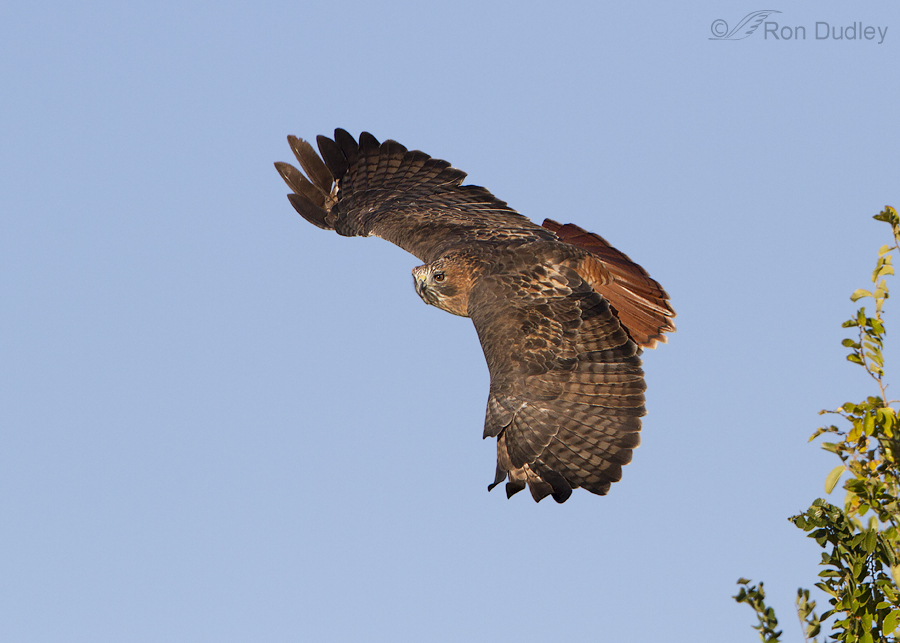
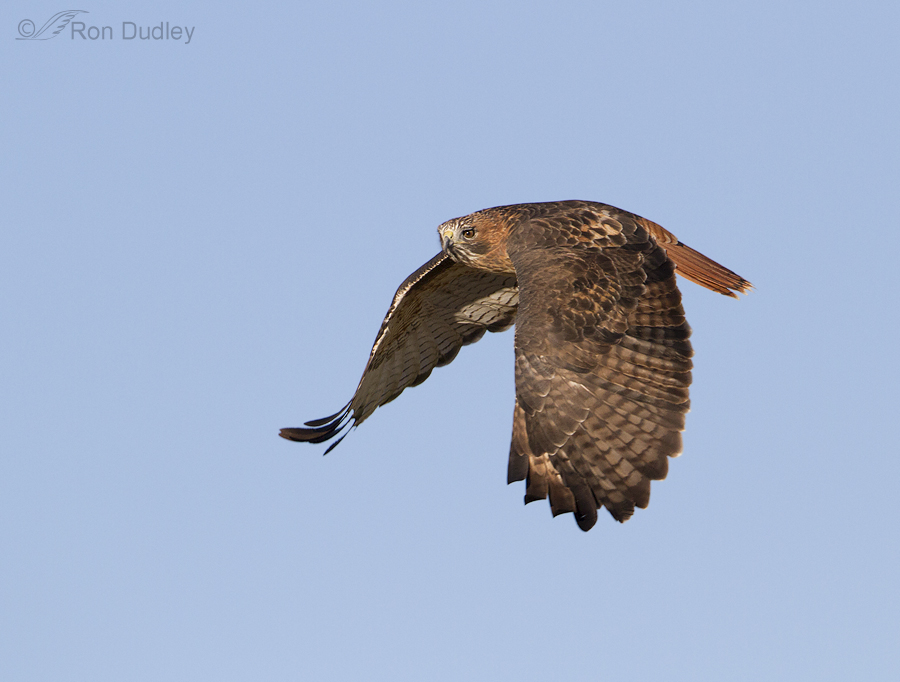
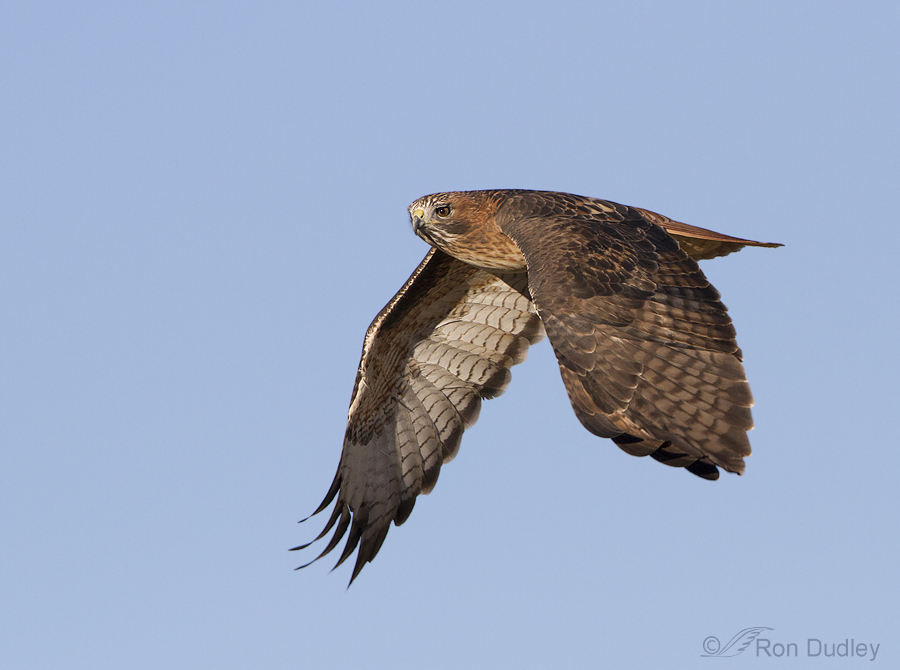
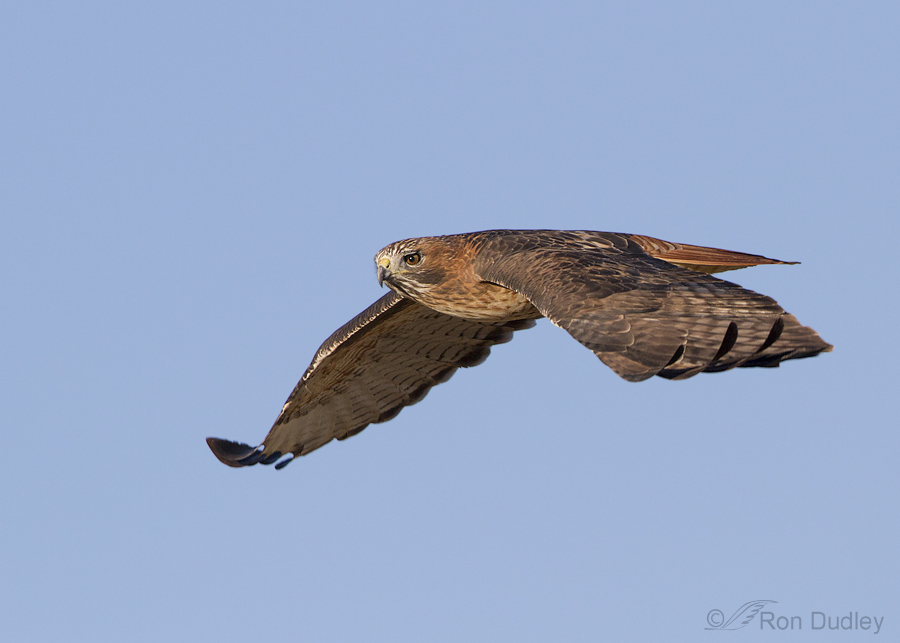
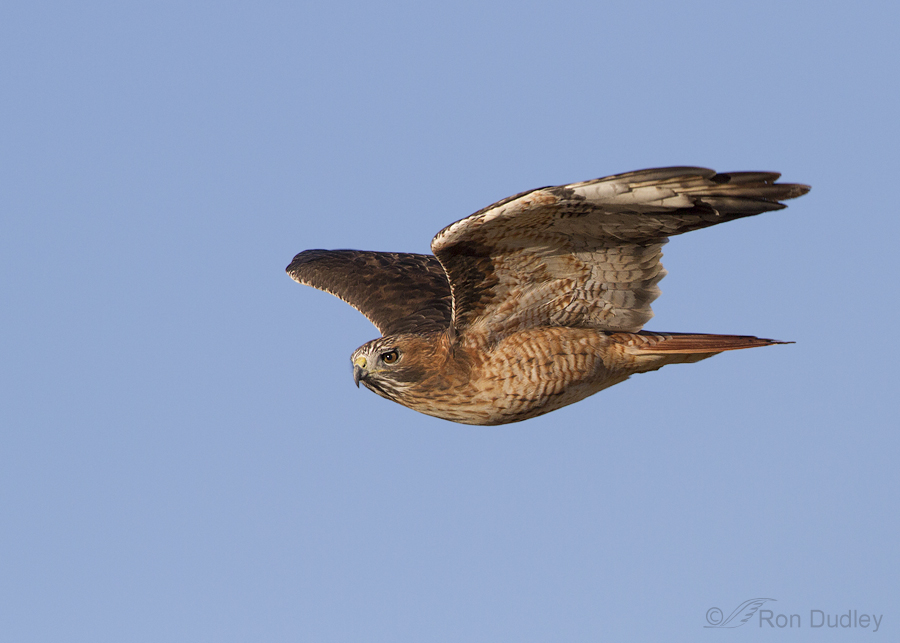
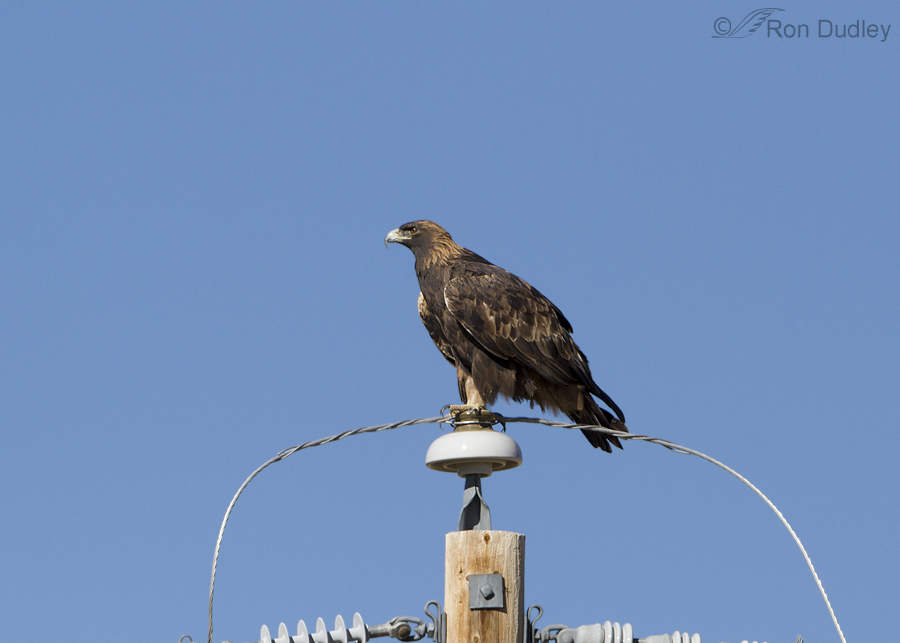
Great eye contact with the red tail and so sharp. I had to smile at the last one, like many of mine. I guess it makes getting the “right shot” even better.
Your shots are just incredible! I know that sometimes photographing can be very frustrating. Most times, I miss shots when glancing away. I have never been a patient person so I just chalk it up to God’s lesson in patience and boy, do I need those lessons.
Thanks so much for sharing your talent and fantastic shots Ron! They are not only fantastic to see, but inspiring and educational as well.
Charlotte
Thanks very much, Charlotte. I didn’t have much patience with birds when I first starting photographing them either but I quickly learned to develop some or settle for lesser shots.
You have some beautiful shots of a beautiful bird with this Red Tail. It took me a very long time of studying the second photo (takeoff) to figure out what exactly I was looking at – placing the various parts of the bird so they made sense. I think this is the third image you’ve posted in the last several months that have been – at least for me – an exercise in deciphering an optical illusion. At least I got this one, finally. It really does seem like this bird is checking you out.
We supposedly have Golden Eagles around here, but I have yet to see one, so I’m happy to see your photo, even if the bird did seek out the ugliest perch it could have found.
Superb shots and, once again, a lesson in how patience pays off. Interesting subject on LBH syndrome.
Have a good week, Ron!
Thanks very much, Wally. I have patience with birds, probably because there’s no other choice!
He was definitely checking you out. A cat can look at king, and a raptor can survey a Ron. Seems only fair – and he did give you some stunning shots.
I wish they’d check me out more often, Elephant’s Child – I like the angle when they do.
Beautiful birds, exceptional shots (I even like the eagle but I always worry about those power poles.)
I worry about them too, Tana. I was out there again this morning and have to admit that I looked at the base of this pole as I passed by…
Hi Ron,
Although this image of the Golden Eagle may not be up to your standards, it is perfect for my needs. I do a lot of education with electric utility lineman, teaching raptor identification and natural history. Would you be will to allow me to use this image in my presentations? With full credit to you, of course!
Cheers,
Gail
Thanks, Gail. I’ll contact you by email.
Thanks Ron!
What a handsome RT Ron. You nailed it.
Better luck next time with the eagle. I’m sure this winter you’ll finally hit it with that bird. Can’t wait.
Bryce, I have to admit that I wondered if this eagle was one of those you were monitoring out in the west desert last year. Hope things are going well with you up in Idaho!
I LOVE your photos, and really like your comments, i.e.:
“It takes great concentration and patience to remain focused on the bird for such a long time as you await for a take-off that happens very fast and often without warning. I swear that sometimes they watch me and deliberately wait until I’ve lost concentration for a nanosecond and then purposely choose that split second to launch.”
I can’t tell you how many times I have experienced the above!!!! It’s definitely frustrating, but it makes me appreciate the photos I do get even more!
Your photographs are magnificent…I really look forward to your postings!
And I can tell from your comment, Pamela that you know very well the frustrations of those untimely take-offs. But if it were easy it wouldn’t be as much fun when things go right…
I knew caged birds like parakeets had to have things like cuttlefish, blocks, or sanded perches in their cages to help keep their beaks, and claws from growing too long…and that sometimes they even have to be trimmed…but didn’t realize this ever happened in the wild.
I open each day looking at your photos…I can’t remember a single morning where I not only saw one or more incredibly beautiful images, but that I was also lucky enough to learn something new and interesting…like Mark Runnels information today.
Thanks, Patty. And I agree, Mark’s contributions here are invaluable.
Hi Ron, Nice shots of the Red Tail, but the eagle has one interesting aspect as well. Notice how overgrown its beak is? We see this with captive birds that are fed super high quality (but soft) food such as quail, (not enough pulling an tearing to keep their beak worn down), but we very seldom see this in a wild raptor. I can’t help but wonder if that is a good sign, or a bad sign. The bird looks to be mature and in otherwise good condition. Probably not an issue, but interesting none the less.
Whoaaa, I hadn’t noticed that, Mark – thanks for pointing it out.
I’m sure it’s not the same condition but did you ever see this post about “long billed hawk syndrome”?
https://www.featheredphotography.com/blog/2011/11/06/red-tailed-hawk-with-long-billed-hawk-syndrome/
Hi Ron- That bird in the linked blog was headed to being a statistic. There is something weird about that hawk too. LBH syndrome always (in my experience) affect either the upper or lower beak. From what I can see in the picture, it looks like BOTH halves of the beak are affected. Not good in any case. Thanks for the great photos.
Mark, I’m out the door in about 5 minutes – headed for the west desert in quest of raptors again (also hoping to avoid all the deer hunters). I’ll get back to you when I return…
Mark, I saw this bird on several more mornings after those shots were taken and it was hunting successfully at the time. I watched it catch and (awkwardly) eat several voles. But I agree, it likely didn’t have much of a future…